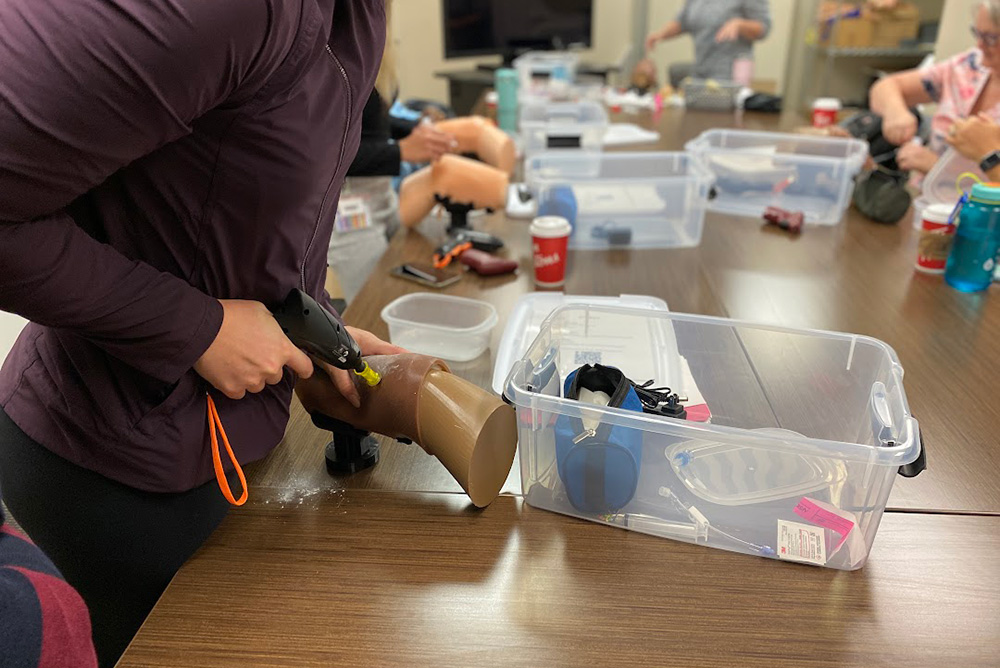Simulation Axercises Lakeridge health Critical Care staff practice proper marking and insertion tecniques in 2024

Simulation axercises Lakeridge health Critical Care staff practice proper marking and insertion tecniques – Lakeridge Health’s Critical Care staff are perfecting landmarking and correct insertion techniques using advanced simulation training drills. These significant technological advancements have made it more practical for health-care professionals to enhance their skills in a safe, controlled environment, thanks to the innovative efforts of researchers at Ontario Tech University. Medical simulation exercises offer a valuable resource for nurses and other health professionals to develop competencies related to surgical and emergency situations without any risk to real patients or staff.
Medical simulators provide a platform for health professionals to practice and repeat scenarios as often as necessary, eliminating the need for real human patients. Despite these advancements, access to high-quality simulation training programs remains unequal within the profession. (Read More : Administrative staff at Shared Health were terminated after the NDP targeted a new bureaucracy in 2024)
Addressing Skill Development Disparities

Recognizing the inconsistencies in skill development opportunities, Ontario Tech’s Faculty of Health Sciences (FHSc) partnered with Lakeridge Health’s Critical Care Program to bridge this gap. This community-based collaboration aims to improve access to high-quality simulation resources both locally and globally. Leading this initiative is Dr. Adam Dubrowski, Canada Research Chair (CRC) in Health-Care Simulation, in partnership with Jann Weary, RN, from Lakeridge Health.
The CRC-funded collaboration focuses on developing cost-effective and scalable simulation tools and platforms to standardize simulation curricula, ensuring uniform training opportunities for all health professionals.
Ensuring the Highest Standards of Patient Care
Over the past two years, Lakeridge Health observed an increased need for rapid intraosseous (IO) infusions, a critical procedure for emergency situations where intravenous access is difficult. With a post-COVID nursing shortage and many new hires, the skill of IO insertion became rare among staff. Existing educational materials were outdated and no longer provided realistic simulations for IO insertion.
To address this, Lakeridge Health turned to maxSIMhealth and Ontario Tech FHSc graduate students, particularly Julia Micallef, one of Dr. Dubrowski’s doctoral students, to develop new, cost-effective simulators. These new simulators were rigorously tested and redesigned to better serve their purpose. The updated simulators were then used to train RNs in Critical Care, and the success of this initiative led to its expansion to the Emergency and Respiratory Therapy departments. Now, every new hire in the hospital’s Critical Care Unit receives this training during onboarding, and it has recently been extended to Queen’s University medical student residents working in Lakeridge Health Critical Care in Oshawa. (Read More: Trek-Focused Fitness Programs 2024: Elevating Health Amidst Nature’s Splendor)
Innovative Health-Care Simulation and Cost Savings
Beyond redeveloping IO simulators, maxSIMhealth provided Lakeridge Health with innovative solutions for simulation training drills that were historically expensive and had limited lifespans. They introduced a cost-effective alternative using small handheld drills equipped with custom-made 3D-printed drill adaptors, transforming household items into simulated life-saving equipment. These devices were even adopted by Swedish physician Dr. Patrik Hallmén to develop a cost-effective training program for military medics on the front lines of the Russia-Ukraine war.
Expanding Impact: Pediatric Training and Intravenous Practice Kits
Building on the success of the IO insertion training project, the hospital’s Emergency Department and maxSIMhealth are now creating similar simulators tailored for pediatric care. Additionally, they are developing intravenous (IV) cannulation practice kits that allow frontline staff to practice IV insertions with blood flashback, a feature previously unavailable at Lakeridge Health. (Read More: Nurturing Well-being: A Holistic Approach to Health and Wellness)
Quotes
“Our work with Lakeridge Health enhances health-care training by creating affordable, scalable simulation tools, ensuring high-quality skill development and improved patient care.”
- Dr. Adam Dubrowski, Canada Research Chair in Health-Care Simulation, Faculty of Health Sciences, Ontario Tech University
“These simulation tools are more realistic and user-friendly than historical tools, ensuring staff are better prepared and confident when they need to use this skill on a patient. This absence of delays in obtaining IV access has improved patient care during emergency events.”
- Jann Weary, Clinical Practice Leader, Lakeridge Health Critical Care Program
Conclusion article Simulation axercises Lakeridge health Critical Care staff practice proper marking and insertion tecniques
The partnership between Ontario Tech University and Lakeridge Health is revolutionizing health-care training through innovative, cost-effective simulation tools. By standardizing and improving access to high-quality simulation resources, this collaboration ensures that health professionals are well-prepared to provide the highest standards of patient care. The ongoing development and expansion of these training programs highlight the commitment to addressing skill development disparities and enhancing patient outcomes.
Read More : The Journey to Fitness: A Holistic Approach to Health and Well-being





